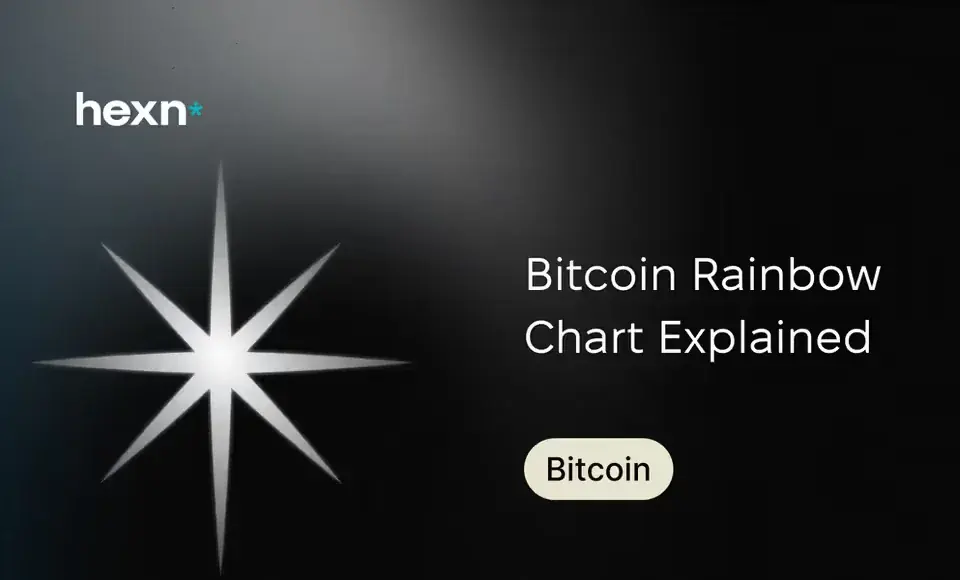Bitcoin Rainbow Chart Explained
The Bitcoin Rainbow Chart is a simple, color-coded way to view BTC's long-term price history and to get a quick sense of whether the market looks cheap, fair, or frothy. It’s popular because it turns complex log-scale data into an easy visual — but it’s not a silver bullet. Understanding how the chart is built and how to combine it with other tools is key to using it well.
How the Rainbow Bands Map Price and Sentiment
The chart overlays a series of colored bands on a logarithmic price axis. Where the current price sits inside those bands is interpreted as a rough signal of market sentiment: lower bands hint at undervaluation, middle bands suggest fair value, and upper bands imply overvaluation. Because the chart uses a log scale, it compresses big swings and highlights long-term trends rather than day-to-day noise.
Origins and Evolution of the Visualization
The original rainbow-style overlay began as a playful visualization of bitcoin’s price in the mid-2010s. Later updates refined the underlying formula, producing a curved regression that aims to follow long-run price behavior more smoothly. Those revisions transformed the chart from a novelty into a more formalized trend reference, though the model remains rooted in historical prices.
Using the Bitcoin Rainbow Chart Step-by-Step
1. Find the Current Band
Start by locating today’s BTC price on the chart and identifying the colored band that contains it. This gives an immediate, visual snapshot of where the market sits relative to the chart’s historical ranges.
2. Translate the Color into a View on Value
Each color represents a different implied valuation level. A common way to interpret the bands is:
- Dark blue — Deep bargain: extreme undervaluation and potential buying opportunity.
- Cyan — Strong buy: clearly undervalued relative to the long-term curve.
- Green — Accumulate: modestly undervalued.
- Light green — Cheap-ish: somewhat below the long-term trend.
- Yellow — Fair value: around the long-term mean.
- Orange — Overextended: possibly overvalued, exercise caution.
- Light red — FOMO territory: likely overvalued with heightened risk.
- Red — Bubble warning: strong signs of overvaluation; risk of sharp corrections.
- Dark red — Extreme froth: historical peaks where downside risk is elevated.
3. Check Historical Patterns in Similar Bands
Look back to see what typically followed when prices entered the same band in prior cycles. Did prices often rebound, drift sideways, or crash? Historical context can reveal whether a band tends to precede fast gains, long consolidations, or corrections.
4. Combine the Rainbow with Other Data
The rainbow chart is best used as one input among many. Useful complements include:
- Trading volume: rising volume often supports a price move; weak volume can signal fragile trends.
- Trend indicators: moving averages, RSI, and MACD help confirm momentum and potential reversals.
- Macro and liquidity factors: interest rates, inflation expectations, and overall liquidity influence risk appetite and crypto prices.
How Reliable is the Rainbow Chart?
It’s Grounded in Past Data
The chart is constructed from historical price behavior, so it shines at showing long-term context. But any model tied to the past can miss turning points driven by new technology, regulation, or macro shocks.
It Uses Logarithmic Regression
By applying a log-scale regression, the chart smooths out volatility and traces a long-term trend. That helps filter noise, but the choice of regression and parameters affects the result and is not universally definitive.
Color Bands Involve Judgment
The number, width, and labeling of bands are subjective. Different versions or parameter tweaks can change what a given color implies, so treat color zones as guidance, not hard rules.
Practical Benefits
- Provides a quick visual of where current prices sit versus historical ranges.
- Helps frame long-term buying and selling decisions within a historical context.
- Translates complex log-scale data into an accessible chart for non-experts.
Key Limitations
- Relies heavily on historical price series and may underweight new market realities.
- Subjective design choices can alter interpretation between different chart versions.
- Not a timing tool for short-term trades — it’s best for framing long-run outlooks.
Are Rainbow Charts Used for Other Cryptocurrencies?
The rainbow idea has been adapted for other major assets. Similar color-band visuals can be applied to other coin price histories to get a comparable read on long-term sentiment, but each asset behaves differently and requires its own calibration.
Final Thoughts
The Bitcoin Rainbow Chart is a handy way to visualize long-term price ranges and to spark further analysis. It offers fast insight into perceived valuation levels, but it should be paired with technical indicators, volume analysis, and macro awareness. Use the chart as a starting point, not a sole decision-maker.
